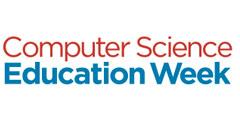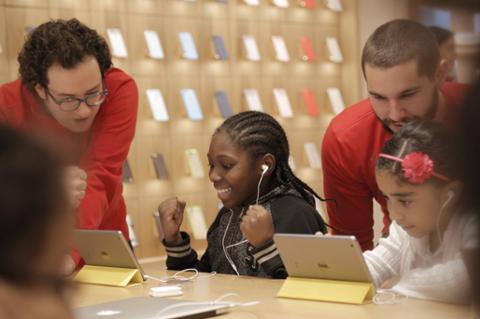Even before Computer Science Education Week kicks off on Dec. 9, a number of educators have immersed their students into the world of computers and coding. Part of the week-long program calls for every student in the U.S. to spend at least one hour learning to code, actually coding or being introduced to coding as part of an “Hour of Code.” At Ocean View Elementary School in Albany, Calif., school librarian/media specialist Ray Pedersen introduced an Hour of Code tutorial to a student whose crutches kept him in the library during lunch. Soon, other students gathered round. As a result, Pedersen began presenting his tutorial to more students the next day. Now he plans to run it even beyond Computer Science Education Week during lunchtime. “It's inspiring to see this in action,” he says. Next week, Pedersen plans to have all of the library’s 18 desktops and 30 Chromebook laptops running the tutorial.
Coding Robots
Pedersen also runs an afterschool program that teaches 4th- and 5th-graders how to build robots and program them using SNAP!, a drag-and-drop programming language. Right now, these Robotic Club students are in the building phase. During Computer Science Education Week, they’ll program their foam-core robots. Pedersen says that three of the 19 students involved already know how to program. Adam Tatarkhanov, an Ocean View fifth-grader, is one of those three. He’s been dabbling in programming since last year, when he asked his engineer father how to code and his dad introduced him to Python. “I wanted to learn how to code because I wanted to design a 3-D animated movie,” Adam says. “At first, I thought coding was easy, but as I did it, it was really, really hard.” Adam is working with several other students to create a dancing Ninja monkey robot. Once the monkey is programmed, its head and arms will move and its eyes will light up. The 10-year-old says the most exciting part of the project will be the programming. "I like challenging things and programming it will be the hardest," he says. Another student, fourth-grader Camila Urteaga, has never programmed before but is excited at the idea of making her team's “Mr. Candy” robot come to life. Her group plans to have the robot hold a box of fake candy and instruct interested nibblers to “Take only one.” Anyone who tries to take a second piece is in for a robotic tongue-lashing. "My mom is a programmer and I like talking to her about our robot," says Camila. "I never asked her to show me how to program but now I might."
Hacking in High School
The College Board says 2,978 high schools across the country offer Advanced Placement computer science courses. One of them is Berkeley High School in Berkeley, Calif., which offers an introduction to computer science program. Instructor Peter Bloomsburgh says 69 of the school's 3,200 students are taking some form of computer programming class. Although Bloomsburgh would like to expose all students to programming during the Hour of Code, doing so is a logistically challenging proposition. That said, he hopes some workarounds can be found for next year. Meanwhile, demand for Berkeley High's computer science classes is growing. Bloomsburgh’s class allows students to work at their own pace in a Massive Open Online Course that’s supported by in-class assistance and written materials. One of the students involved is 11th-grader Lena Correia. “I don't know if I want to be a software engineer, but I definitely want to work in the computer field,” she says. “I'm really enjoying it and the insight I'm gaining. I now know how things are made using a computer and it's fun to learn new languages.” Michael Szegedy, another 11th-grader, takes the school’s AP computer science class though he’s set his sights on a bio-engineering career. In middle school, he was introduced to C by his father, a computer science professor at Rutgers University in New Jersey. He’s using the Torque 3-D engine to create a game where users can design their own proteins. He hopes the game can be used to recruit people into bio-engineering.
Birth of the Hour of Code
Computer Science Education Week is organized by the educational non-profit Code.org and Computing in the Core, an advocacy group. In a recent interview with Dice News, Code.org Co-Founder Hadi Partovi said the Hour of Code is meant to demystify computer science: “We have an opportunity to lift up an entire generation of youth, and we’re starting with one hour, one student, one classroom and one school at a time.” Code.org’s goal is to have 10 million students in the U.S. get some exposure to coding -- an audacious, aspirational goal, Partovi admits. Still, it’s an important first step. “We expect the vast majority of Hour of Code participants will be having their first experience with learning computer science,” Partovi says.



